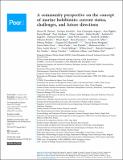Por favor, use este identificador para citar o enlazar a este item:
http://hdl.handle.net/10261/236653COMPARTIR / EXPORTAR:
 SHARE SHARE
 CORE
BASE CORE
BASE
|
|
| Visualizar otros formatos: MARC | Dublin Core | RDF | ORE | MODS | METS | DIDL | DATACITE | |

| Título: | A community perspective on the concept of marine holobionts: current status, challenges, and future directions |
Autor: | Dittami, Simon M.; Arboleda, Enrique; Auguet, Jean-Christophe CSIC ORCID; Brigalke, Arite; Briand, Enora; Cárdenas, Paco; Cardini, Ulisse; Decelle, Johan; Engelen, Aschwin H.; Eveillard, Damien; Gachon, Claire M. M.; Griffiths, Sarah M.; Harder, Tilmann; Kayal, Ehsan; Kazamia, Elena; Lallier, François H.; Medina, Mónica; Marzinelli, Ezequiel M.; Morganti, Teresa Maria; Núñez Pons, Laura; Prado, Soizic; Pintado, José CSIC ORCID; Saha, M.; Selosse, Marc-André; Skillings, Derek; Stock, Willem; Sunagawa, Shinichi; Toulza, Eve; Vorobev, Alexey; Leblanc, Catherine; Not, Fabrice CSIC ORCID | Palabras clave: | Evolution Ecosystem services Symbiosis Host-microbiota interactions, Marine holobionts Dysbiosis |
Fecha de publicación: | 2021 | Editor: | PeerJ | Citación: | PeerJ 9: e10911 (2021) | Resumen: | Host-microbe interactions play crucial roles in marine ecosystems. However, we still have very little understanding of the mechanisms that govern these relationships, the evolutionary processes that shape them, and their ecological consequences. The holobiont concept is a renewed paradigm in biology that can help to describe and understand these complex systems. It posits that a host and its associated microbiota with which it interacts, form a holobiont, and have to be studied together as a coherent biological and functional unit to understand its biology, ecology, and evolution. Here we discuss critical concepts and opportunities in marine holobiont research and identify key challenges in the field. We highlight the potential economic, sociological, and environmental impacts of the holobiont concept in marine biological, evolutionary, and environmental sciences. Given the connectivity and the unexplored biodiversity specific to marine ecosystems, a deeper understanding of such complex systems requires further technological and conceptual advances, e.g., the development of controlled experimental model systems for holobionts from all major lineages and the modeling of (info)chemical-mediated interactions between organisms. Here we propose that one significant challenge is to bridge cross-disciplinary research on tractable model systems in order to address key ecological and evolutionary questions. This first step is crucial to decipher the main drivers of the dynamics and evolution of holobionts and to account for the holobiont concept in applied areas, such as the conservation, management, and exploitation of marine ecosystems and resources, where practical solutions to predict and mitigate the impact of human activities are more important than ever | Descripción: | 34 pages, 4 figures.-- Distributed under Creative Commons CC-BY 4.0 | Versión del editor: | http://doi.org/10.7717/peerj.10911 | URI: | http://hdl.handle.net/10261/236653 | DOI: | 10.7717/peerj.10911 | E-ISSN: | 2167-8359 |
| Aparece en las colecciones: | (IIM) Artículos |
Ficheros en este ítem:
| Fichero | Descripción | Tamaño | Formato | |
|---|---|---|---|---|
| Community_perspective_OA_2021.pdf | 4,14 MB | Adobe PDF |  Visualizar/Abrir |
CORE Recommender
PubMed Central
Citations
17
checked on 30-abr-2024
SCOPUSTM
Citations
47
checked on 06-may-2024
WEB OF SCIENCETM
Citations
38
checked on 29-feb-2024
Page view(s)
112
checked on 07-may-2024
Download(s)
77
checked on 07-may-2024

